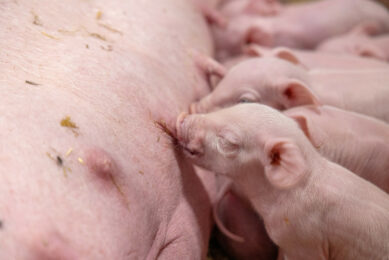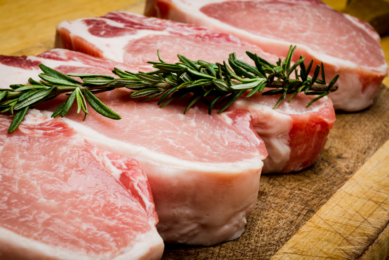Genome editing for disease resistance in pigs and chickens

For thousands of years humans have used selective breeding to improve desirable traits in both livestock and companion animals. However, breeding for resistance to pathogens has proven more difficult. Genome editing can offer an efficient and reliable way to help tackle this issue.
In livestock, targeted breeding has been common practice since the 18th century, with measurable production traits actively selected for. At the end of the last century, genomic selection was added to the livestock breeding tool box; by reading specific locations in the genome and assigning them to production traits, faster improvement in livestock production efficiency has been achieved. However, one of the most difficult production traits to measure is resistance to a specific disease. Genome editing offers new opportunities to livestock breeding for disease resistance as it can take input not only from breeding programmes but also other genetic and laboratory research. It has been applied to a wide variety of agricultural species including farmed fish, bees, pigs, poultry and ruminants. Generation times and litter sizes are major obstacles to (optimising) genome editing technology. Due to its global economic value, relatively short generation time, and large litter sizes the most edited livestock species to date is the pig. However, new advances in the technologies on how to create genome edited chickens means the number of genome edited poultry is on the rise.
Genome edited pigs and chicken
The idea of genome editing is relatively simple; make specific changes to the genome of an animal to introduce a beneficial (new) trait. This new breeding technology is using the tools that both biotechnology and the breeding industry have developed for over half a century. Genome editors are proteins that cut the genomic DNA strands at specific positions. Introducing that cut requires the cell to repair that break. Tweaking this repair, e.g. providing a DNA strand template, can change the outcome of the cut leading to deletions, insertions, or a single letter change.
All the editor reagents introduced to the cell rapidly degrade, leaving only the alteration to the genomic sequence, which will be propagated following cell division and eventually transferred to the next generations through breeding. This technology is revolutionary and provides exciting possibilities for the production of livestock resistant to diseases. Such opportunities are particularly important given state efforts to improve global food security and reduce food waste in the production chain.
There are two main methods widely used for the generation of edited pigs; cloning of edited cells or direct editing in zygotes (embryo after fusion of oocyte and sperm) by injecting editor reagents. For cloning, adult cells are cultivated, genome edited, characterised and specific genetic changes selected. They are then used to reconstitute a zygote-like cell, which is then transferred to a recipient sow. However, cloning is inefficient with hundreds of “zygotes” being transferred to a single recipient, yielding small litter sizes and offspring often demonstrating reduced viability. As an alternative, zygotes can be directly injected with genome editing reagents and transferred immediately back to a recipient animal. This approach results in the efficient establishment of pregnancies and robust litters. However, offspring from direct zygote injection show a range of editing outcomes since selection of a specific genetic change is not possible.
An emerging alternative to these proven methods could be the use of surrogate sires. As a first step towards this goal, pigs have been edited to remove a gene required to make sperm stem cells. As a result, homozygous males don’t produce any sperm cells in their testis. However, the sperm stem cells can be isolated from donors, cultured, genome edited, characterised and selected, before transfer to the surrogate sire’s testis that will then start to produce edited sperm.
Genetic modification of poultry poses unique challenges due to the very different physiology of the avian egg compared to a mammalian oocyte. As a result, isolation and transfer of a chicken yolk at a single-cell stage of the embryo is impossible. Advances in chicken stem cell technology show the greatest promise for genome editing in chicken. Primordial germ cells (stem cells that eventually develop into sperm or oocyte cells) can be isolated from the blood of developing chicks and cultured. These cells can then be edited and selected before transfer into the bloodstream of a recipient embryo where they migrate to and populate the developing gonad. However, the resulting offspring are a mixture of edited and non-edited chicks due to the presence of unedited germ cells in the recipient embryo. Recipient chicken embryos devoid of germ cells have been developed and are significantly increasing the efficiency of this process. Using this technology, the generation of edited chickens may be as short as 6 months.
Progress of gene editing on diseases
Genome editors will undoubtedly have a significant role on the generation of disease resistant animals as exemplified here.
Pigs
Porcine Reproductive and Respiratory Syndrome (PRRS) is arguably the most economically important pig disease worldwide. The causative agent of PRRS is an arterivirus named PRRS virus (PRRSv) and affects pigs of all ages but importantly causes late-term abortions and stillbirth in sows and severe respiratory disease in piglets with severe morbidity and high mortality. PRRSv also incapacitates the pig’s immune response, allowing secondary infections, leading to increased antibiotics use. Like many viruses, PRRSV uses a key-lock interaction with a specific protein, a so-called receptor to gain entry into the cell, where it can replicate itself. In the case of PRRSv this is a protein called CD163. Genome edited pigs lacking all of or only part of CD163 have been shown to be resistant to PRRSv infection. CD163 is known to have a range of important biological functions in homeostasis, inflammation and immune response. Pigs lacking only part of CD163 were shown to maintain the biological functions associated with the protein.
The 2 coronaviruses Porcine Epidemic Diarrhoea virus (PEDv) and Transmissible Gastroenteritis virus (TGEv) both cause severe diarrhoea in pre-weaned piglets and are associated with high morbidity and mortality. Research identified aminopeptidase N as a receptor for TGEv and a potential receptor for PEDv. Genome edited pigs lacking aminopeptidase N were resistant to TGEv but remained susceptible to PEDv infection. Aminopeptidase N is important for peptide digestion in the small intestine and mice lacking the gene function showed delayed mammary gland development. Therefore, further investigations into the impact on the overall health and/or productivity of the animals is warranted.
African Swine Fever virus (ASFv) causes a severe haemorrhagic disease in pigs with high mortality in pigs of all ages. Whilst initially contained to Africa, with its recent rapid spread across Eastern Europe and Asia, ASFv poses a huge risk to the pig industry worldwide. In the late stages of ASFv infection, an overreaction of the immune system is observed, which is thought to strongly contribute to lethality of the disease. Interestingly, ASFv also infects wild suids, such as warthogs, without causing overt disease. A comparison of the warthog and domestic pig genomes identified differences in a gene (RelA) associated with the immune response overreaction. Researchers used genome editing to convert a key region of the domestic pig sequence to the warthog equivalent. Pigs with the warthog equivalent gene region were unfortunately not resistant to ASFv but showed a delayed onset of clinical signs.
Chickens
Avian Leukosis virus (ALV) infection results in inappetence, diarrhoea, weight loss, a reduction in eggs laid, and often causes tumour formation in the chicken. The virus is divided into six subgroups, with the ALV subgroup J shown to be responsible for major disease outbreaks in China. The receptor of ALV-J was identified to be the chicken sodium/hydrogen exchanger 1 protein (chNHE1). Chickens with a single letter change to the chNHE1 protein code show resistance to infection with the ALV-J virus.
In chickens, disease resistance to avian influenza (AI) is at the top of the wish list due to the serious impact on chicken health but also the risk of transmission to humans. Similarly, influenza A is also one of the diseases on the resistance wish list for pigs, as they can act as an intermediate host aiding virus adaptation to humans. The acidic leucine-rich nuclear phosphoprotein-32A (ANP32A) was found to play a key role in AI virus replication in chicken. It has been demonstrated that deletion of a small region of chicken ANP32A can prevent replication of the AI virus. While the functional consequence of edited ANP32A has yet to be demonstrated in chicken, such approaches offer exciting opportunities that have the potential to benefit both industry and animal welfare. Furthermore, preliminary findings show that a similar changes in pig cells may result in resistance or at least prevent “humanisation” of avian influenza viruses.
Genome editing and selective breeding
Selective breeding has generated highly productive, robust animals that are adapted to a modern production environment. Livestock production is dynamic, with evolving challenges such as climate change and disease outbreaks coupled with societal pressure to reduce antimicrobial use. Selective breeding for disease resistance has proven difficult, as outbreaks are often sporadic and resistant/resilient animals are often difficult to identify. Only if a specific genetic location can be identified it may be integrated through selective breeding but only if plenty of animals in the herd have that genetic advantage. A good example of this are pigs with resistance to F18 type enterotoxigenic E.coli bacteria, causing diarrhoea in piglets. Large studies identified an advantageous genetic letter code in the fucosyl transferase 1 gene, which conferred complete resistance to these bacteria. The favourable genetic letter code was present in between 5-10% of the breeding population to allow for selection whilst avoiding inbreeding.
Genome editing has the potential to translate findings from laboratory studies, genetically compare with other (rare or indigenous) breeds or closely related species to be newly integrated into the breeding pool. But also, when a specific desired genomic trait is present at such low frequency that selective breeding would lead to an inbred, vulnerable stock. It is important that before editing, the biological function of a target gene/protein are investigated, and investigated as to whether this genomic locus has been selected for or against in current breeding programmes. Edited animals need to be thoroughly phenotypically analysed to ensure no adverse outcomes of the editing.
Gene editing is the way forward
Overall, genome editing holds vast promise for the future production of animals resistant or resilient to disease, improving productivity and animal welfare whilst reducing food waste in the production chain. Through reduction of primary and secondary infections it should also be possible to reduce antimicrobial use in livestock rearing. Technical improvements in the generation of genome editing animals will undoubtedly reduce the cost implications of this technology. Two major hurdles still to be faced prior to the implementation of this promising technology are consumer acceptance and the regulatory framework. Approval of edited animals for human consumption relies on national and multi-national legislation, which is currently at early stages. Encouragingly, some international jurisdictions such as Argentina and Brazil have already ruled that modifications, such as the PRRSv-resistant pig, that do not have any new genetic information integrated into the animal, will be exempt from regulation.






